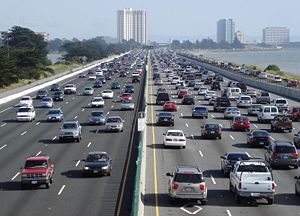Infrastructure
2008/9 Schools Wikipedia Selection. Related subjects: Business

Infrastructure typically refers to the assets that support an economy, such as roading, water supply, wastewater, stormwater, power supply, flood management, recreational and other assets. In the past these assets have typically been owned and managed by local or central government. The investment in these assets is made with the intention that dividends will accrue through increased productivity, improved living conditions and greater prosperity. These various elements may collectively be termed civil infrastructure, municipal infrastructure, or simply public works, although they may be developed and operated as private-sector or government enterprises. A more generic definition of infrastructure is the network of assets "where the system as a whole is intended to be maintained indefinitely at a specified standard of service by the continuing replacement and refurbishment of its components."
Alternative definitions
In other applications, infrastructure may refer to information technology, informal and formal channels of communication, software development tools, political and social networks, or beliefs held by members of particular groups. Still underlying these more general uses is the concept that infrastructure provides organizing structure and support for the system or organization it serves, whether it is a city, a nation, or a corporation. Economically, infrastructure could be seen to be the structural elements of an economy which allow for production of goods and services without themselves being part of the production process, e.g. roads allow the transport of raw materials and finished products.
Typical attributes
Infrastructure assets generally have the following attributes:
• They are large networks constructed over generations which are not often replaced as a whole system
• The system or network has a long and indefinite life because its service capacity is maintained in perpetuity (by continual refurbishment or replacement of components as they wear out).
• The system components are inderdependent and not usually capable of subdivision or separate disposal, and consequently are not readily disposable within the commercial marketplace.
• The system interdependency may limit a component life to a lesser period than the expected life of the component itself.
• The assets have a high initial cost and a value which is difficult to determine.
An asset can be considered to be part of the infrastructure when it is an integral part of a total system, i.e. if the asset is removed the system is incomplete, or the particular asset is necessary for the system to deliver the required standard of service.
Critical infrastructure
The term "critical infrastructure" has been widely adopted to distinguish those infrastructure elements that, if significantly damaged or destroyed, would cause serious disruption of the dependent system or organization. Storm, flood, or earthquake damage leading to loss of certain transportation routes in a city (for example, bridges crossing a river), could make it impossible for people to evacuate and for emergency services to operate; these routes would be deemed critical infrastructure. Similarly, an on-line reservations system might be critical infrastructure for an airline.
History
According to etymology online , the word infrastructure has been around since 1927 and meant: The installations that form the basis for any operation or system. Originally in a military sense. The word is a combination of "infra", meaning "below" and "structure".
The term came to prominence in the United States in the 1980s following the publication of America in Ruins (Choate and Walter, 1981), which initiated a public-policy discussion of the nation’s "infrastructure crisis", purported to be caused by decades of inadequate investment and poor maintenance of public works.
That public-policy discussion was hampered by lack of a precise definition for infrastructure. The U.S. National Research Council committee cited Senator Stafford, who commented at hearings before the Subcommittee on Water Resources, Transportation, and Infrastructure; Committee on Environment and Public Works; that "probably the word infrastructure means different things to different people." The NRC panel then sought to rectify the situation by adopting the term "public works infrastructure", referring to "...both specific functional modes - highways, streets, roads, and bridges; mass transit; airports and airways; water supply and water resources; wastewater management; solid-waste treatment and disposal; electric power generation and transmission; telecommunications; and hazardous waste management - and the combined system these modal elements comprise.
A comprehension of infrastructure spans not only these public works facilities, but also the operating procedures, management practices, and development policies that interact together with societal demand and the physical world to facilitate the transport of people and goods, provision of water for drinking and a variety of other uses, safe disposal of society's waste products, provision of energy where it is needed, and transmission of information within and between communities." In subsequent years the word has grown in popularity and been applied with increasing generality to suggest the internal framework discernible in any technology system or business organization.